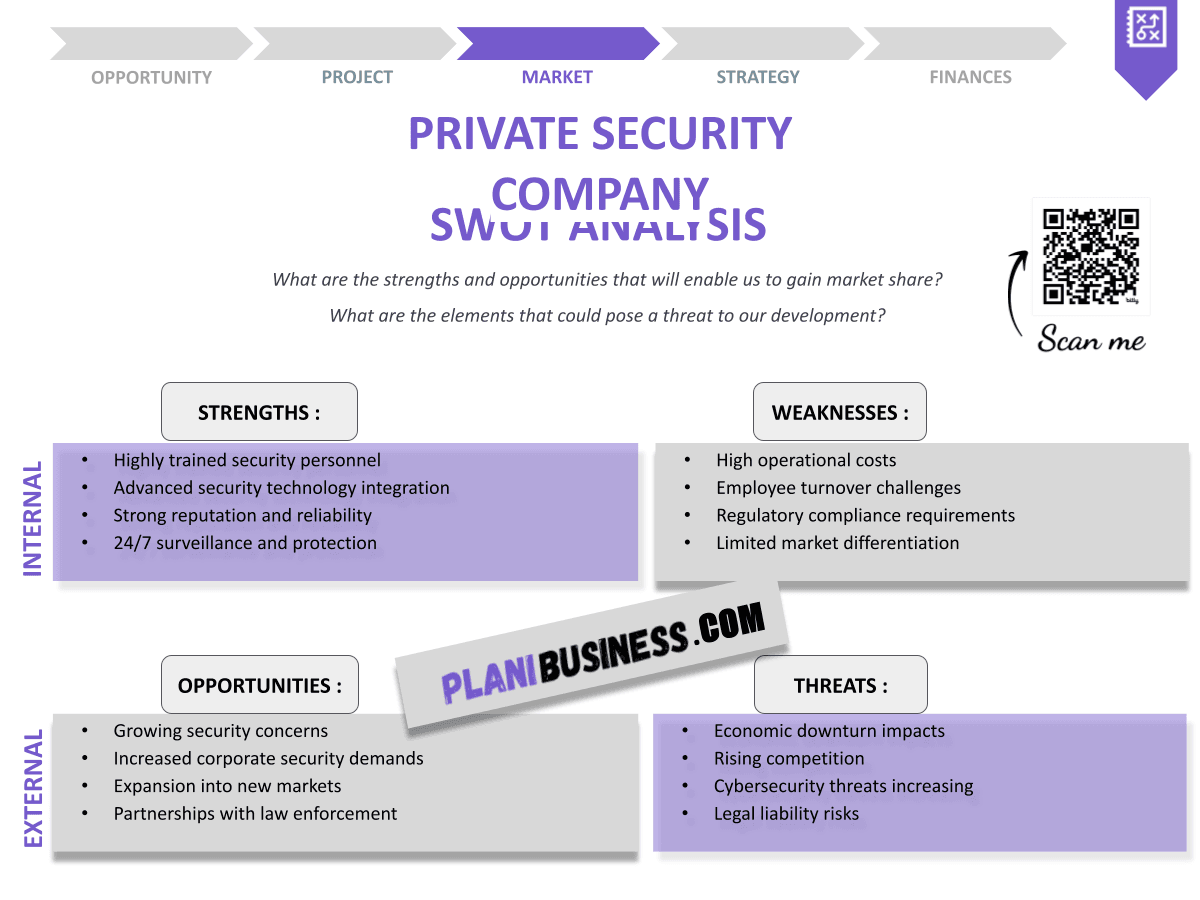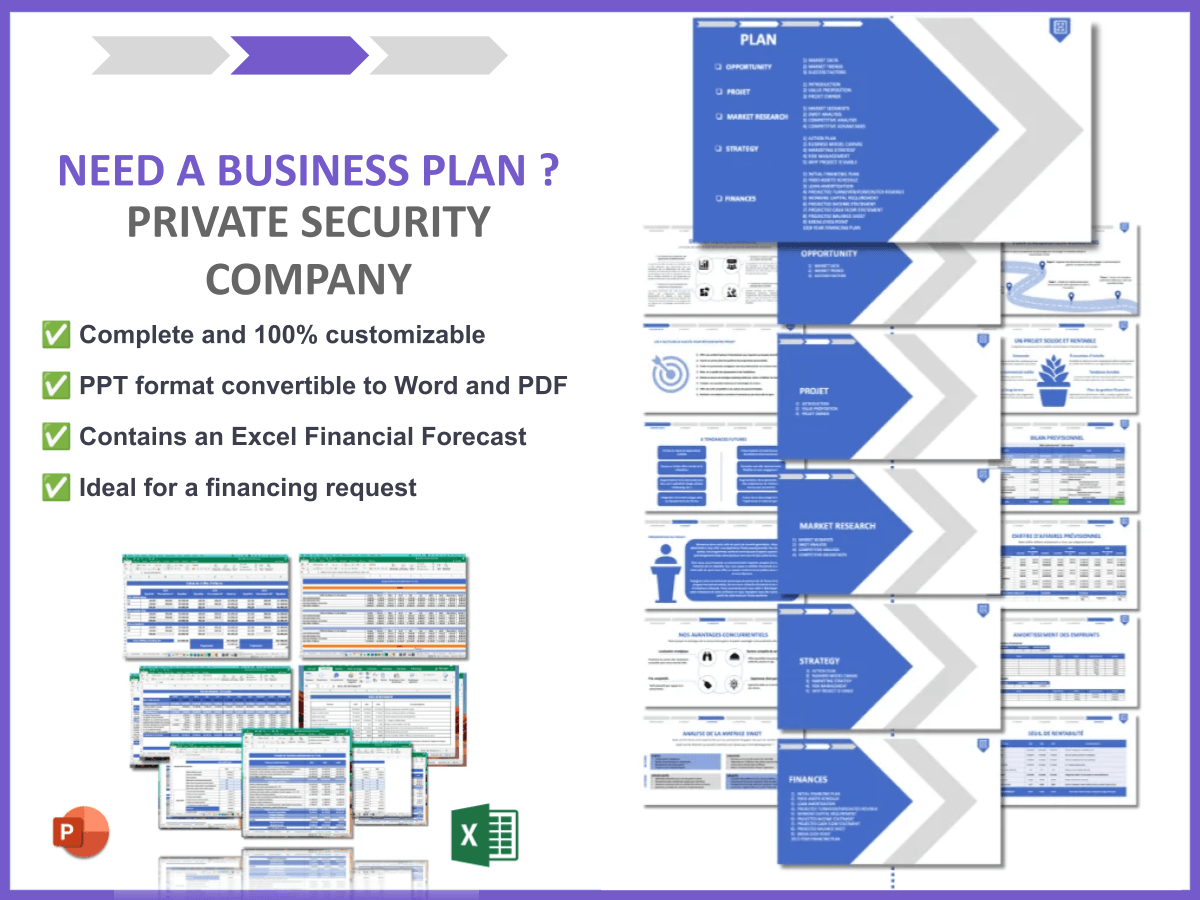Why Should You Have a SWOT Analysis for Your Private Security Company?
Are you aware that 70% of businesses that conduct regular SWOT analyses improve their strategic decision-making? If you’re in the private security industry, understanding your company’s position is crucial. A SWOT analysis helps you identify where you excel and where there’s room for growth. In this article, we’ll dive into the importance of SWOT analysis and how it can propel your business forward.
Definition of SWOT Analysis: A SWOT analysis evaluates your company’s Strengths, Weaknesses, Opportunities, and Threats, providing a framework for strategic planning.
- Importance of SWOT analysis in strategic planning.
- Identifying internal strengths and weaknesses.
- Recognizing external opportunities and threats.
- Real-world examples of SWOT analyses in security companies.
- Actionable steps to create your own SWOT analysis.
- How to leverage strengths for competitive advantage.
- Strategies to mitigate weaknesses.
- Exploring opportunities in the security market.
- Preparing for threats in the industry.
- Conclusion.
How Do You Write a SWOT Analysis for Your Private Security Company?
Creating a SWOT analysis isn’t just about listing factors; it’s about understanding their implications. Let’s break it down.
Strengths
When writing a SWOT analysis for your private security company, start by identifying your strengths. These could include a strong brand reputation, experienced personnel, advanced technology and equipment, or established client relationships. Highlighting these aspects helps you understand what sets your company apart from competitors.
Weaknesses
Next, consider your weaknesses. This might involve analyzing potential high operational costs, reliance on specific contracts or clients, skill gaps in certain areas, or challenges in employee retention. Acknowledging these weaknesses is the first step toward addressing them.
Opportunities
Then, explore the opportunities available to your private security company. Look for growth in demand for private security services, new technology trends like AI and surveillance, potential partnerships with local businesses, or expanding service offerings. Identifying these opportunities can lead to strategic growth.
Threats
Finally, analyze the threats your company might face. This includes competition from other security firms, regulatory changes affecting the industry, economic downturns impacting budgets, or threats from cybercrime and digital security. Being aware of these threats allows you to prepare and strategize effectively.
SWOT Example N°1 for a Local Security Company
This example illustrates how a local security firm conducted its SWOT analysis to enhance its service offerings.
| SWOT | Analysis |
|---|---|
| Strengths | Strong community ties, experienced staff |
| Weaknesses | Limited geographic reach |
| Opportunities | Expansion into neighboring areas |
| Threats | New competitors entering the market |
- Strong community presence.
- Experienced personnel.
- Need for expansion.
- Competitive market pressures.
- This example shows how local firms can leverage community ties for growth while recognizing the need for expansion to mitigate geographic limitations.
SWOT Example N°2 for a National Security Company
This example highlights how a national security company utilized SWOT analysis to refine its marketing strategy.
| SWOT | Analysis |
|---|---|
| Strengths | National recognition, diverse service portfolio |
| Weaknesses | High operational costs |
| Opportunities | Government contracts |
| Threats | Economic downturns |
- National recognition enhances trust.
- Diverse services appeal to various clients.
- High costs limit profitability.
- Economic shifts pose risks.
- The analysis indicates that while national firms enjoy recognition, they must manage costs effectively to remain competitive.
SWOT Example N°3 for a Technology-Driven Security Company
This example focuses on a technology-centric security firm that leveraged its strengths in innovation.
| SWOT | Analysis |
|---|---|
| Strengths | Innovative technology solutions |
| Weaknesses | Dependence on tech staff |
| Opportunities | Growing demand for smart security |
| Threats | Rapid tech changes |
- Innovative solutions attract tech-savvy clients.
- Staff dependency can create vulnerabilities.
- Market demand for smart solutions is rising.
- Need to adapt to tech advancements quickly.
- This SWOT analysis emphasizes the balance between innovation and the need for versatile staffing.
SWOT Example N°4 for a Family-Owned Security Business
This example examines how a family-run business evaluated its unique position through SWOT analysis.
| SWOT | Analysis |
|---|---|
| Strengths | Personalized service, community focus |
| Weaknesses | Limited marketing budget |
| Opportunities | Local partnerships |
| Threats | Larger firms with more resources |
- Personalized service builds loyalty.
- Budget constraints limit outreach.
- Local partnerships can boost visibility.
- Competition from larger firms is a concern.
- This analysis shows how family businesses can thrive by emphasizing personal connections while being strategic about partnerships.
SWOT Example N°5 for a New Security Startup
This example explores how a startup navigated its early challenges through SWOT analysis.
| SWOT | Analysis |
|---|---|
| Strengths | Fresh perspective, agility |
| Weaknesses | Lack of brand recognition |
| Opportunities | Niche markets |
| Threats | Established competitors |
- Fresh ideas can disrupt markets.
- Brand recognition is crucial for trust.
- Niche markets present unique opportunities.
- Competition from established players is daunting.
- The SWOT highlights the startup's agility as a strength but points out the need for strategic branding.
SWOT Example N°6 for a Luxury Security Service
This example looks at a luxury security service‘s SWOT analysis focusing on its high-end clientele.
| SWOT | Analysis |
|---|---|
| Strengths | High-quality service, exclusive clientele |
| Weaknesses | High service costs |
| Opportunities | Growth in luxury market |
| Threats | Economic fluctuations |
- High-quality service builds reputation.
- Service costs may deter potential clients.
- Luxury market growth offers opportunities.
- Economic downturns can impact clientele.
- This SWOT analysis showcases how luxury services must balance high costs with maintaining exclusivity.
SWOT Example N°7 for a Security Consulting Firm
This example discusses how a consulting firm utilized SWOT analysis to enhance its service offerings.
| SWOT | Analysis |
|---|---|
| Strengths | Expertise in security strategies |
| Weaknesses | Limited hands-on service capabilities |
| Opportunities | Increased demand for consulting |
| Threats | New entrants in consulting |
- Expertise builds trust with clients.
- Limited hands-on capabilities can hinder service.
- Demand for consulting is rising.
- Increased competition in consulting.
- The analysis illustrates the need for consulting firms to diversify their offerings while leveraging expertise.
SWOT Example N°8 for an Event Security Company
This example explores how an event security company adapted its strategies through SWOT analysis.
| SWOT | Analysis |
|---|---|
| Strengths | Experience in large events |
| Weaknesses | Seasonal demand |
| Opportunities | Growth in event industry |
| Threats | Economic downturns |
- Experience enhances service quality.
- Seasonal demand impacts revenue.
- Event industry growth offers opportunities.
- Economic shifts can reduce event budgets.
- This SWOT highlights how seasonal businesses can prepare for fluctuating demand by exploring year-round opportunities.
SWOT Example N°9 for a Community-Based Security Initiative
This example discusses how a community-focused initiative used SWOT analysis to enhance local safety.
| SWOT | Analysis |
|---|---|
| Strengths | Strong community ties |
| Weaknesses | Limited funding |
| Opportunities | Grants for community safety |
| Threats | Community apathy |
- Strong ties foster collaboration.
- Funding limitations restrict growth.
- Grants can enhance safety initiatives.
- Apathy can hinder community engagement.
- This analysis shows how community initiatives can thrive with strong ties while addressing funding challenges.
SWOT Example N°10 for a Security Training Academy
This example looks at how a training academy for security professionals used SWOT analysis.
| SWOT | Analysis |
|---|---|
| Strengths | Experienced trainers |
| Weaknesses | Limited course offerings |
| Opportunities | Growing demand for trained personnel |
| Threats | Online training competitors |
- Experienced trainers enhance credibility.
- Course limitations can deter enrollments.
- Demand for training is rising.
- Online competition is significant.
- This SWOT highlights the need for training academies to diversify their course offerings in the face of competition.
Conclusion
In summary, conducting a SWOT analysis for your private security company is not just a task; it’s a strategic necessity. Understanding your strengths, weaknesses, opportunities, and threats can significantly impact your decision-making process. By evaluating these factors, you can develop effective strategies that drive growth and success in your business.
If you’re looking to take the next step, consider utilizing a comprehensive business plan template for a Private Security Company available at this link. It provides a structured approach to establishing your company.
Additionally, you can explore our articles on how to build a private security company by visiting this guide, and learn how to plan a private security company marketing strategy with examples by checking out this resource. These insights will help you navigate the complexities of the security industry effectively.
FAQ
What is a SWOT analysis?
A SWOT analysis is a strategic tool that helps organizations assess their Strengths, Weaknesses, Opportunities, and Threats in a structured manner.
Why is SWOT analysis crucial for private security companies?
It allows companies to identify internal and external factors that can influence their performance and strategic direction.
How often should a SWOT analysis be performed?
It is advisable to conduct a SWOT analysis regularly, ideally on an annual basis or whenever significant changes occur in the business environment.
Can a SWOT analysis aid in decision-making?
Absolutely! It provides valuable insights that inform strategic decisions and enhance risk management.
What are common strengths in security firms?
Common strengths include a strong brand reputation, highly experienced personnel, and advanced technology and equipment.
What weaknesses should security companies consider?
High operational costs and dependence on specific contracts or clients are typical weaknesses to address.
How can companies capitalize on identified opportunities?
By developing strategies that align with market trends and customer needs, companies can effectively leverage their opportunities.
What threats should security companies monitor?
Competition, regulatory changes, and economic downturns are significant threats that need to be monitored closely.
How do you create a SWOT analysis?
Gather a team, brainstorm each section, and analyze the findings collectively to create a comprehensive SWOT analysis.
Are there templates available for conducting a SWOT analysis?
Yes, many templates are accessible online to guide you through the process of conducting a SWOT analysis.







